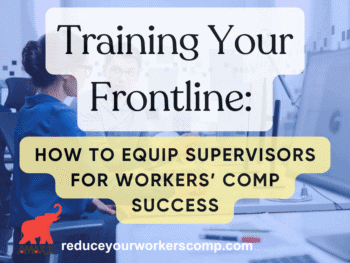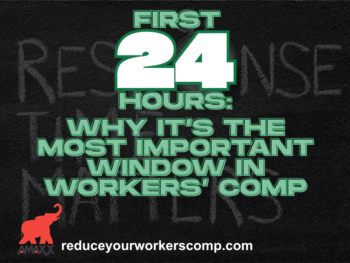
Benefits of an Effective Post-Injury Response
There are numerous benefits to an effective post-injury response. This all starts with an evaluation of education provided to your workforce, buy-in from all interested stakeholders, and an effective system for reporting injuries.
- Ensures accurate reporting of a work injury and the correct information is being received;
- Ensures the injured employee receives timely medical care from a competent medical provider; and
- Ensures employees can return to work quicker, which reduces money spent on a claim.
The best post-injury response involves everyone – employees, supervisors, medical providers, and members of the claim management team. Make sure everyone is on board with this aspect of your program.
Click Link to Access Free PDF Download
“9-Element Blueprint To Create Your Workers’ Comp Employee Brochure”
Components of a Post-Injury Response
There are many essential components to an effective post-injury response. When implemented correctly, interested stakeholders can ensure that injuries will be reported timely and efficiently. It is a win-win situation for all interests.
- Enable employees to report injuries immediately. Studies indicate injuries reported within 24 hours have less time missed from work and fewer dollars spent on medical care.
- Involvement of the supervisors in ensuring proper medical care is provided to the employee. Tools at their disposal should include access to an injury triage nurse.
- Coordination of the supervisor and managers regarding the reporting of any injury. This exchange of information allows for appropriate policies and procedures to be followed after an injury.
- Immediate and proper medical care for the employee using injury triage. This is important in instances where the employee requires off-site medical care. Transportation to this health care provider can help build workplace morale.
- Dispensing information regarding the workers’ compensation process. Information that needs to be shared with the employee can include a brochure on the claims process, instructions the employee needs to follow, and completion of a report of workability. This is information that can assist in return to work issues.
- Proper reporting of the work injury to the insurance carrier. It is usually the employer’s responsibility to report the injury to the carrier. Issues concerning primary liability are then coordinated and made by the claim team.
- Coordination of return to work issues. Following a work injury, getting the employee back to work reduces workers’ compensation costs. Every employer should have a dedicated person responsible for these matters.
Interested stakeholders can create various tools to ensure every step of a post-injury response takes place. This can include flowcharts and checklists. It also requires dedication by all management levels to ensure nothing is missed.
Other Intangibles in Post-Injury Response
Post-injury response should never stop once the employee is stabilized and receives proper medical care. Employers and other interested stakeholders can take other steps to ensure the employee receives their benefits on time and build trust.
- Engage the employee in weekly meetings. These meetings can be in-person, via WebEx, or telephone.
- Send the employee a “get well soon” card. Anything you can do to emphasize with the employee will not go unnoticed.
- Examine workers’ compensation metrics regularly and determine what works and needs improvement.
The effective post-injury response takes time, effort, and dedication. Now is the time to determine how your process is working. Never forget the human element of a workplace injury.
Conclusions
Failing to check all the boxes following a work injury can cause delay and add costs to your program. A close examination of your program includes ensuring everyone understands the benefits of an effective response and following the processes. Taking these steps and ensuring the injured employee receives benefits quickly improves your bottom line.
 Author Michael Stack, CEO Amaxx LLC. He is an expert in workers’ compensation cost containment systems and helps employers reduce their workers’ comp costs by 20% to 50%. He works as a consultant to large and mid-market clients, is a co-author of Your Ultimate Guide To Mastering Workers Comp Costs, a comprehensive step-by-step manual of cost containment strategies based on hands-on field experience, and is the founder & lead trainer of Amaxx Workers’ Comp Training Center, which offers the Certified Master of Workers’ Compensation national designation.
Author Michael Stack, CEO Amaxx LLC. He is an expert in workers’ compensation cost containment systems and helps employers reduce their workers’ comp costs by 20% to 50%. He works as a consultant to large and mid-market clients, is a co-author of Your Ultimate Guide To Mastering Workers Comp Costs, a comprehensive step-by-step manual of cost containment strategies based on hands-on field experience, and is the founder & lead trainer of Amaxx Workers’ Comp Training Center, which offers the Certified Master of Workers’ Compensation national designation.
Contact: mstack@reduceyourworkerscomp.com.
Workers’ Comp Roundup Blog: http://blog.reduceyourworkerscomp.com/
©2022 Amaxx LLC. All rights reserved under International Copyright Law.
Do not use this information without independent verification. All state laws vary. You should consult with your insurance broker, attorney, or qualified professional.

















